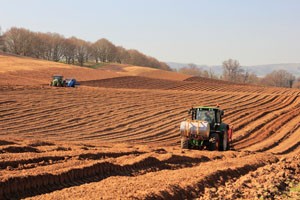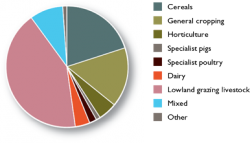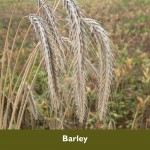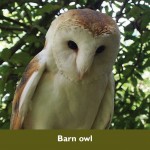
Farmland includes wildlife habitats such as grassland, arable land and hedgerows. The quality of farmland habitats for wildlife can vary enormously, ranging from species-rich unimproved grasslands to intensively managed grasslands which support very little wildlife.
Arable cropland is a great place to see some of the UK’s rarest farmland birds. These include corn bunting, grey partridge, skylark and stone curlew. The National Park is also considered to be a national hotspot for rare arable plants. In addition to plants and birds, farmland habitats also support some interesting and special mammals such as harvest mouse and brown hare. Farm hedges and field margins act as ‘wildlife corridors’ for many species including bats.
While the extent of farmland has probably not changed significantly over the past century, the balance of different uses has varied a great deal. Over the last 50–100 years the quality of many farmland habitats for wildlife has declined dramatically. Increasing intensification of agriculture as a result of farming subsidies in the latter half of the 20th century had a devastating impact upon many species of wildlife dependent on farmland habitats.
Modern herbicides and seed cleaning methods reduced the presence of arable plants such as rough poppy. Changes in arable cropping practices such as a switch from spring to autumn sown cereals has reduced habitat and food availability for farmland birds and other wildlife.
Proportions of different habitats which make up farmland have also changed in recent history, for example, significant amounts of sheep-grazed chalk downland were ploughed up during and after World War II to grow crops such as wheat and barley, and over the past decade vineyards have increased in number.
A good proportion of farms are on the Environmental Stewardship scheme. This scheme enables farmers and land managers to make a living and also contribute to improving biodiversity and habitats for wildlife. Actions taken often have the added benefit of reducing the need for pesticides by increasing the numbers of natural predators.
Resources Toolbox
General Interest
All Ages
-

Grey Partridge on the Sussex Downs - Norfolk Estate
Update on the scientific work being carried out to improve the conservation of farmland birds. -

Look after your land with Environmental Stewardship
An interactive pdf document about the Environmental Stewardship Scheme. Includes funding and advice to help farmers undertake work to conserve and improve the countryside. -

Why Farming Matters to the South Downs
An education pack filled with information, activities and lesson ideas for learning about farming in the South Downs National Park.
Key Stage 1
Ages 5–7
Years 1 and 2
Key Stage 2
Ages 7–11
Years 3, 4, 5 and 6
-

Why Farming Matters - Activity Pack
Welcome to Why Farming Matters, a teaching resource containing a wealth of activity ideas for Key Stage 2 classes. Teachers can select individual activities or deliver them all as part of a topic on food and farming. Why Farming Matters is a collaborative project by Farming & Countryside Education (FACE) and the National Farmers' Union (NFU). -

Why Farming Matters to the South Downs
An education pack filled with information, activities and lesson ideas for learning about farming in the South Downs National Park.
Key Stage 4
Ages 14–16
Years 10 and 11
-

Grey Partridge on the Sussex Downs - Norfolk Estate
Update on the scientific work being carried out to improve the conservation of farmland birds. -

NGOET Grey Partridge Presentation
An excellent presentation about the conservation of the grey partridge on farmland from the National Gamekeepers Organisation Education Trust. Contains a case study from the Norfolk Estate, illustrated by figures and maps.
Key Stage 5
Ages 16–18
Years 12 and 13
-

Grey Partridge on the Sussex Downs - Norfolk Estate
Update on the scientific work being carried out to improve the conservation of farmland birds. -

NGOET Grey Partridge Presentation
An excellent presentation about the conservation of the grey partridge on farmland from the National Gamekeepers Organisation Education Trust. Contains a case study from the Norfolk Estate, illustrated by figures and maps.
HE & FE
Higher and Further Education
-

Grey Partridge on the Sussex Downs - Norfolk Estate
Update on the scientific work being carried out to improve the conservation of farmland birds. -

Look after your land with Environmental Stewardship
An interactive pdf document about the Environmental Stewardship Scheme. Includes funding and advice to help farmers undertake work to conserve and improve the countryside. -

NGOET Grey Partridge Presentation
An excellent presentation about the conservation of the grey partridge on farmland from the National Gamekeepers Organisation Education Trust. Contains a case study from the Norfolk Estate, illustrated by figures and maps.






